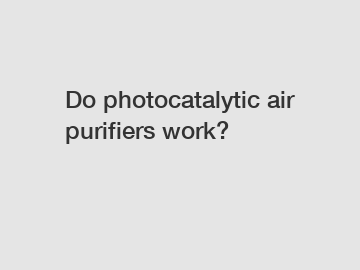Do photocatalytic air purifiers work?
While we often take the air we breathe for granted, indoor air quality has a significant impact on our overall well-being. As we witness a rising concern for clean and safe air, numerous technologies have emerged to combat air pollutants effectively. One particular technology that has gained popularity in recent times is the photocatalytic air purifier. But the question remains: do these air purifiers really work? In this blog, we will explore the science behind these devices, their mechanism of action, and their efficiency in providing cleaner, healthier air.
Understanding Photocatalysis:
Photocatalysis is a process that utilizes light energy to accelerate chemical reactions involving a catalyst. In the context of air purification, the photocatalytic air purifier employs a catalyst, typically titanium dioxide (TiO2), which when activated by ultraviolet (UV) light, triggers a chemical reaction that breaks down harmful pollutants in the air. This reaction results in the conversion of pollutants into harmless compounds, such as carbon dioxide and water vapor.

The Mechanism at Work:
When airborne pollutants, including volatile organic compounds (VOCs), odors, and bacteria, come into contact with the surface of the catalyst, the photocatalytic oxidation process is initiated. UV light activates the catalyst, which generates charged particles known as electron-hole pairs. These pairs react with water molecules present in the air, producing hydroxyl radicals (OH•) and superoxide ions (O2•-), potent oxidants that neutralize pollutants.
Such an oxidizing process can break down a wide range of organic compounds, effectively reducing indoor air pollution. Notably, the efficiency of photocatalytic air purifiers is influenced by factors such as light intensity, duration of exposure, and the extent and type of pollutants present.
Evaluating the Efficiency:
Numerous studies have been conducted to assess the effectiveness of photocatalytic air purifiers. Research findings have shown promising results, particularly in the removal of formaldehyde, a common indoor pollutant found in building materials and furniture. One study conducted by renowned scientists compared the performance of a photocatalytic air purifier with a traditional air purifier and found that the photocatalytic variant achieved a considerable reduction in formaldehyde levels.
However, it is important to note that the effectiveness of photocatalytic air purifiers may vary depending on the specific type and concentration of pollutants present. While they are highly effective against organic volatile compounds, their performance against other pollutants, such as dust and allergens, may be limited. Therefore, it is advisable to analyze the specific requirements and goals of a particular indoor environment before investing in a photocatalytic air purifier.
Addressing Concerns:
Despite their potential, some concerns have been raised regarding the safety of photocatalytic air purifiers. One particular concern involves the formation of potentially harmful byproducts during the photocatalytic process. However, extensive research on the topic has indicated that the formation of such byproducts is minimal and well below the established safety thresholds. That being said, it is crucial to ensure that the air purifier adheres to safety standards and has been certified by reputable organizations.
Conclusion:
As we strive for cleaner and healthier indoor environments, technologies like photocatalytic air purifiers offer a promising solution. Based on the principles of photocatalysis, these devices have demonstrated significant potential in removing various volatile organic compounds and improving indoor air quality. However, it is essential to understand that their effectiveness is influenced by a range of factors, including light intensity and exposure duration. Prioritizing the specific pollutants you aim to address will help determine whether a photocatalytic air purifier is the right choice for you.
With ongoing scientific investigations and improved technologies, the future of photocatalytic air purifiers appears bright. These innovative devices continue to evolve, offering a valuable tool in our pursuit of cleaner, safer breathing spaces. Remember to consult professionals, read product specifications, and make informed decisions to ensure you choose the air purifier best suited for your unique needs. Clean air is within our grasp, and photocatalytic air purifiers are playing their part in making indoor spaces healthier and more comfortable for everyone.
If you are looking for more details, kindly visit air purification activated carbon filter element, Oil Purifier Filters Denmark, buy blower filter.
102
0
0


Comments
All Comments (0)